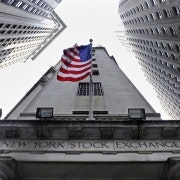Lehman's ghost haunts banks from beyond the grave
Five years ago, the markets plunged into an Alice-in-Wonderland world. For when Lehman Brothers collapsed, the repercussions were so violent investors were faced with confronting “six impossible things before breakfast” each day, to paraphrase Lewis Carroll.
So as markets mark the anniversary of that Lehman collapse, is the system any safer or saner? The answer is both “yes” and “no”. The good news is the chance of another full-blown banking crisis has receded. Some of the crazier innovations have been reined in, banks are better capitalised, and financiers act more cautiously.
But the bad news is that the system is just as insane, perhaps more so. There are a host of developments that are at best counterintuitive, and at worst dangerously bizarre. Investors may no longer face six new banking shocks before breakfast, but there are at least six peculiar features of the post-Lehman world that might make Alice blink.
First, the big banks are bigger - not smaller. When Lehman collapsed, there was outrage about the fact that many western banks had become so enormous they were “too big to fail”, forming concentrations of risk. Reformers called for banks to be broken up, to make them smaller and introduce badly needed diversity. Some financial officials, such as Richard Fisher of the Dallas Fed, continue to demand this sensible step. But, as the investor Henry Kaufman points out, the banking world, especially in the US, has become more concentrated than ever. That is unnerving, particularly since no one knows how regulators would ever shut down a really big bank.
Second, the shadow banking world is taking over more activity, not less. When Lehman failed, regulators suddenly realised they had been ignoring the non-bank sphere, enabling egregious behaviour to flourish. Given that, you might have expected those shadows to shrink. But think again: it has expanded since 2008 from $US59 trillion ($A63.66 trillion) in size to $US67 trillion, according to the Financial Stability Board. And it is likely to swell further, because tighter bank regulations are pushing more and more activity into the non-bank world. The FSB insists it has become better at monitoring these shadows; we had all better hope it is right.
Third, the system depends more than ever on investors’ faith in central banks. One issue that caused the last credit bubble was excessive investor trust in the abilities of central bankers, both to keep inflation low and to understand how financial innovation worked. Logic might suggest this blind faith should have wilted after Lehman Brothers failed. Not so — these days all manner of asset prices are being propped up by a sunny investor belief that central bankers know what they are doing with quantitative easing, even though nobody has tried it on this scale before, or knows how to exit.
Fourth, the rich have become richer. The Lehman Brothers crisis triggered a surge of popular anger against wealthy elites, hence the rise of the Tea Party, Occupy Wall Street, and other protest groups. But that has not caused elites to lose wealth. On the contrary, one (largely unacknowledged) consequence of quantitative easing is that this has increased asset prices and thus benefited the asset-rich wealthy elite, widening inequalities. The Bank of England, for example, calculates that 40 per cent of the QE benefit has gone to the top 5 per cent, including those bankers.
Fifth, financiers have been prosecuted, but not for the credit bubble. After Lehman’s collapse, politicians demanded banker prosecutions, and initially this seemed likely to occur. After all, almost 2,000 financial professionals were convicted following the 1990s savings and loans crisis in the US. But while senior financiers have been hauled off in handcuffs since 2008, this has generally not been due to credit bubble issues. Bernard Madoff is a prime example.
Lastly, Fannie and Freddie are alive and well. Back in 2008, it seemed self-evident that the rotten entities of Fannie Mae and Freddie Mac were overdue for reform; indeed, it was a crisis in those state-backed housing finance agencies in August 2008 that started the chain of events leading to the Lehman shock. But five years later, Fannie and Freddie are more entrenched than ever, accounting for more than 90 per cent of the US mortgage market, up from 60 per cent before.
An optimist might argue these six factors are only temporary distortions; some observers might insist they were inevitable. Housing would have suffered badly without Fannie and Freddie underwriting the mortgage market, for example. But if nothing else, these issues are a potent illustration of the law of unintended consequences, and a powerful reminder of the vast amount of work still to be done before we have a financial world that looks both sane and safe.













